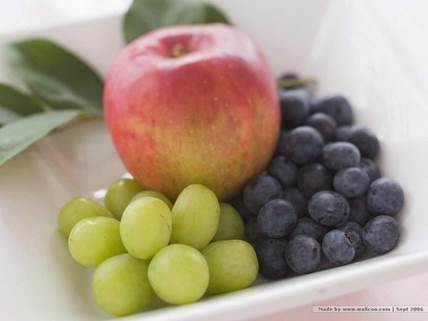 Eating more fruit, particularly blueberries, apples and grapes, is linked to a reduced risk of developing type-2 diabetes, suggests a study in the British Medical Journal.Blueberries cut the risk by 26% compared with 2% for three servings of any whole fruit - but fruit juice did not appear to have the same effect. The research looked at the diets of more than 187,000 people in the US. In these studies, 6.5% of participants (12,198 out of 187,382) developed type-2 diabetes. The studies used food frequency questionnaires to follow up the participants every four years, asking how often, on average, they ate a standard portion of each fruit. Eating more fruit, particularly blueberries, apples and grapes, is linked to a reduced risk of developing type-2 diabetes, suggests a study in the British Medical Journal.Blueberries cut the risk by 26% compared with 2% for three servings of any whole fruit - but fruit juice did not appear to have the same effect. The research looked at the diets of more than 187,000 people in the US. In these studies, 6.5% of participants (12,198 out of 187,382) developed type-2 diabetes. The studies used food frequency questionnaires to follow up the participants every four years, asking how often, on average, they ate a standard portion of each fruit.
 The fruits used in the study were grapes or raisins, peaches, plums or apricots, prunes, bananas, cantaloupe, apples or pears, oranges, grapefruit, strawberries and blueberries. The researchers' analysis of the data showed that three servings per week of blueberries, grapes and raisins, and apples and pears significantly reduced the risk of type-2 diabetes. While all fruit was shown to reduce the risk, these fruits appeared to be particularly effective.
"The juicing process gets rid of the fruit, just leaving fluids which are absorbed more quickly, causing blood sugars and insulin levels to rise if they contain sugars. "To try to minimize the risk of type-2 diabetes as much as possible it is reasonable to reduce fruit juice consumption and increase consumption of whole fruits." Says Prof Qi Sun, Harvard Medical School who is part of the research team The fruits used in the study were grapes or raisins, peaches, plums or apricots, prunes, bananas, cantaloupe, apples or pears, oranges, grapefruit, strawberries and blueberries. The researchers' analysis of the data showed that three servings per week of blueberries, grapes and raisins, and apples and pears significantly reduced the risk of type-2 diabetes. While all fruit was shown to reduce the risk, these fruits appeared to be particularly effective.
"The juicing process gets rid of the fruit, just leaving fluids which are absorbed more quickly, causing blood sugars and insulin levels to rise if they contain sugars. "To try to minimize the risk of type-2 diabetes as much as possible it is reasonable to reduce fruit juice consumption and increase consumption of whole fruits." Says Prof Qi Sun, Harvard Medical School who is part of the research team
|
 |

